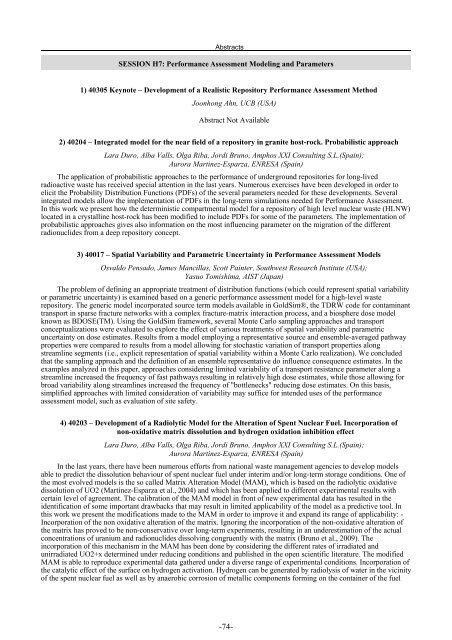ASME Message
ASME Message
ASME Message
Create successful ePaper yourself
Turn your PDF publications into a flip-book with our unique Google optimized e-Paper software.
Abstracts<br />
SESSION H7: Performance Assessment Modeling and Parameters<br />
1) 40305 Keynote – Development of a Realistic Repository Performance Assessment Method<br />
Joonhong Ahn, UCB (USA)<br />
Abstract Not Available<br />
2) 40204 – Integrated model for the near field of a repository in granite host-rock. Probabilistic approach<br />
Lara Duro, Alba Valls, Olga Riba, Jordi Bruno, Amphos XXI Consulting S.L.(Spain);<br />
Aurora Martinez-Esparza, ENRESA (Spain)<br />
The application of probabilistic approaches to the performance of underground repositories for long-lived<br />
radioactive waste has received special attention in the last years. Numerous exercises have been developed in order to<br />
elicit the Probability Distribution Functions (PDFs) of the several parameters needed for these developments. Several<br />
integrated models allow the implementation of PDFs in the long-term simulations needed for Performance Assessment.<br />
In this work we present how the deterministic compartmental model for a repository of high level nuclear waste (HLNW)<br />
located in a crystalline host-rock has been modified to include PDFs for some of the parameters. The implementation of<br />
probabilistic approaches gives also information on the most influencing parameter on the migration of the different<br />
radionuclides from a deep repository concept.<br />
3) 40017 – Spatial Variability and Parametric Uncertainty in Performance Assessment Models<br />
Osvaldo Pensado, James Mancillas, Scott Painter, Southwest Research Institute (USA);<br />
Yasuo Tomishima, AIST (Japan)<br />
The problem of defining an appropriate treatment of distribution functions (which could represent spatial variability<br />
or parametric uncertainty) is examined based on a generic performance assessment model for a high-level waste<br />
repository. The generic model incorporated source term models available in GoldSim®, the TDRW code for contaminant<br />
transport in sparse fracture networks with a complex fracture-matrix interaction process, and a biosphere dose model<br />
known as BDOSE(TM). Using the GoldSim framework, several Monte Carlo sampling approaches and transport<br />
conceptualizations were evaluated to explore the effect of various treatments of spatial variability and parametric<br />
uncertainty on dose estimates. Results from a model employing a representative source and ensemble-averaged pathway<br />
properties were compared to results from a model allowing for stochastic variation of transport properties along<br />
streamline segments (i.e., explicit representation of spatial variability within a Monte Carlo realization). We concluded<br />
that the sampling approach and the definition of an ensemble representative do influence consequence estimates. In the<br />
examples analyzed in this paper, approaches considering limited variability of a transport resistance parameter along a<br />
streamline increased the frequency of fast pathways resulting in relatively high dose estimates, while those allowing for<br />
broad variability along streamlines increased the frequency of "bottlenecks" reducing dose estimates. On this basis,<br />
simplified approaches with limited consideration of variability may suffice for intended uses of the performance<br />
assessment model, such as evaluation of site safety.<br />
4) 40203 – Development of a Radiolytic Model for the Alteration of Spent Nuclear Fuel. Incorporation of<br />
non-oxidative matrix dissolution and hydrogen oxidation inhibition effect<br />
Lara Duro, Alba Valls, Olga Riba, Jordi Bruno, Amphos XXI Consulting S.L.(Spain);<br />
Aurora Martinez-Esparza, ENRESA (Spain)<br />
In the last years, there have been numerous efforts from national waste management agencies to develop models<br />
able to predict the dissolution behaviour of spent nuclear fuel under interim and/or long-term storage conditions. One of<br />
the most evolved models is the so called Matrix Alteration Model (MAM), which is based on the radiolytic oxidative<br />
dissolution of UO2 (Martínez-Esparza et al., 2004) and which has been applied to different experimental results with<br />
certain level of agreement. The calibration of the MAM model in front of new experimental data has resulted in the<br />
identification of some important drawbacks that may result in limited applicability of the model as a predictive tool. In<br />
this work we present the modifications made to the MAM in order to improve it and expand its range of applicability: -<br />
Incorporation of the non oxidative alteration of the matrix. Ignoring the incorporation of the non-oxidative alteration of<br />
the matrix has proved to be non-conservative over long-term experiments, resulting in an underestimation of the actual<br />
concentrations of uranium and radionuclides dissolving congruently with the matrix (Bruno et al., 2009). The<br />
incorporation of this mechanism in the MAM has been done by considering the different rates of irradiated and<br />
unirradiated UO2+x determined under reducing conditions and published in the open scientific literature. The modified<br />
MAM is able to reproduce experimental data gathered under a diverse range of experimental conditions. Incorporation of<br />
the catalytic effect of the surface on hydrogen activation. Hydrogen can be generated by radiolysis of water in the vicinity<br />
of the spent nuclear fuel as well as by anaerobic corrosion of metallic components forming on the container of the fuel<br />
-74-


